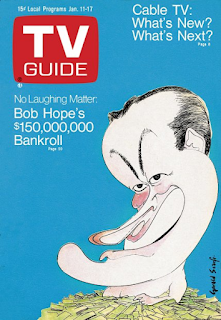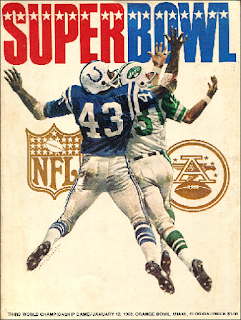This week in TV Guide: January 11, 1969
 There is no mention of it on the cover, no story on the inside, no viewer's guide with recipes for the parties held on the big day. Instead, at 3:00 p.m. ET on Sunday, January 13, there is just a simple listing: "Super Bowl." It's accompanied by a full-page closeup containing the lineups of the two teams: the AFL champion New York Jets, and the NFL champion Baltimore Colts.
There is no mention of it on the cover, no story on the inside, no viewer's guide with recipes for the parties held on the big day. Instead, at 3:00 p.m. ET on Sunday, January 13, there is just a simple listing: "Super Bowl." It's accompanied by a full-page closeup containing the lineups of the two teams: the AFL champion New York Jets, and the NFL champion Baltimore Colts.It is, of course, one of the most celebrated football games ever played, and one of the most consequential. When the Jets defeated the Colts 16-7, the result catapulted Jets quarterback Joe Namath from simple stardom to a cultural fame so pervasive that the remnants of it continue to this day. It gave a final, unmistakable credibility to the American Football League, and an abject humiliation to the National Football League, ensuring that the AFL would never again be thought of as a junior partner in the professional football business (an equality sealed the following season with Kansas City's victory over Minnesota). If Baltimore's victory over the New York Giants in the 1958 sudden death championship game had established pro football as a major league sport, the third Super Bowl game guaranteed its place in the pantheon of American pop culture.
 Did you ever notice the NFL logo on
Did you ever notice the NFL logo onthis program is wrong?It was a very painful experience for my eight-year-old self; as observant readers may recall, the Colts were my second-favorite team, next to the invincible Green Bay Packers. Oh, I enjoyed the AFL a great deal; it's just that when push came to shove, my allegiance was squarely with the Colts, as it had been with the Packers, and as it would be the following year with the hometown Vikings. The defeat was a bitter pill to swallow, and as the outcome became evident in the waning minutes, my frustration overcame me and I bit the coffee table in exasperation, leaving an impression of eight or ten teeth in what must have been rather soft wood. (It was still there nearly 30 years later, when the table was sold, although Old English Leather does wonders with hiding the defects.) I don't need to go into the sordid details, nor the ramifications of said action, but it gave me a lifetime animus toward Namath, who must surely be the most overrated player in the Hall of Fame—statistically he was a lousy quarterback, his lasting contribution being due more to what he did for the AFL (as well as his off-field activities). It left me unimpressed with Colts coach Don Shula, who clearly didn't have his team prepared. It even made me resent the Miami Dolphins in a sort of guilt-by-association, simply because they played in the Orange Bowl, site of the debacle. Well, there's no accounting for pre-teenage reasoning.
And yet there's nothing particularly remarkable about it in this issue. The full-page closeup is no more than that given to the first two Super Bowls. The Seagram's ad urging viewers to "Watch the Game with a Friend" is the same one that appears for every big sporting event. That ad for Chap Stick is there because it's the official lip balm of the National Football League, not the American. There's no indication that this game is more important than any other championship game. It doesn't dominate the pages; there are no variety shows built around it, no Super Bowl-themed episodes of any regular series, and if, for some absurd reason, you were to skip the Sunday listings, you wouldn't know anything was going on. It's not even in prime time, for heaven's sake. Actually, it's all kind of nice, don't you think?
Published on January 12, 2019 05:00
No comments have been added yet.
It's About TV!
Insightful commentary on how classic TV shows mirrored and influenced American society, tracing the impact of iconic series on national identity, cultural change, and the challenges we face today.
- Mitchell Hadley's profile
- 5 followers



